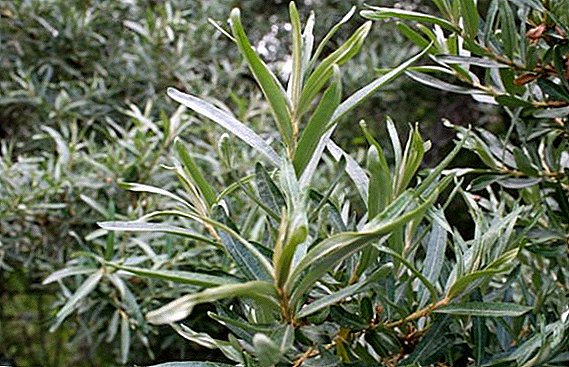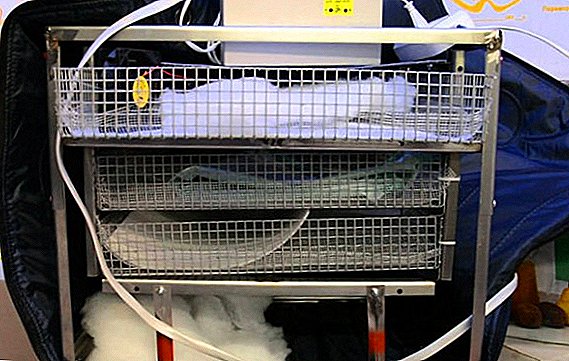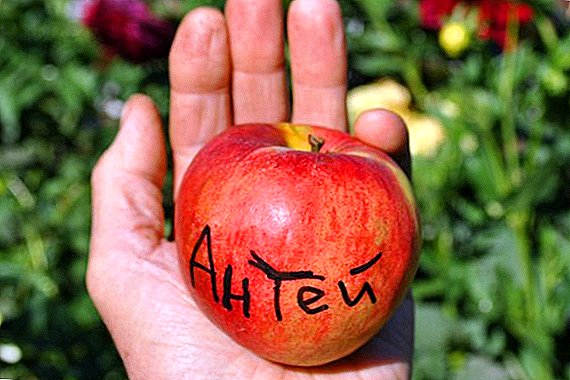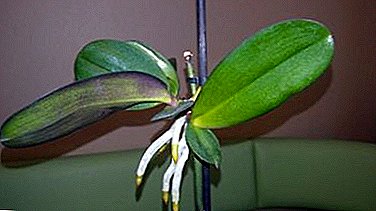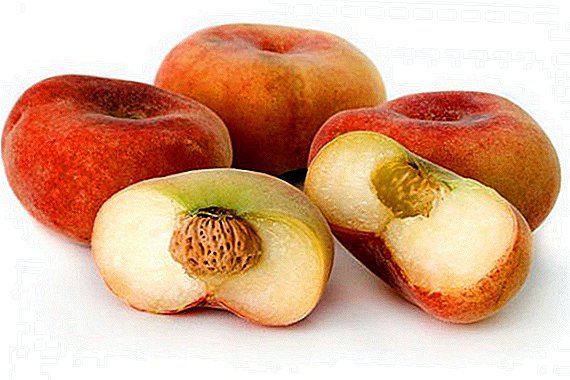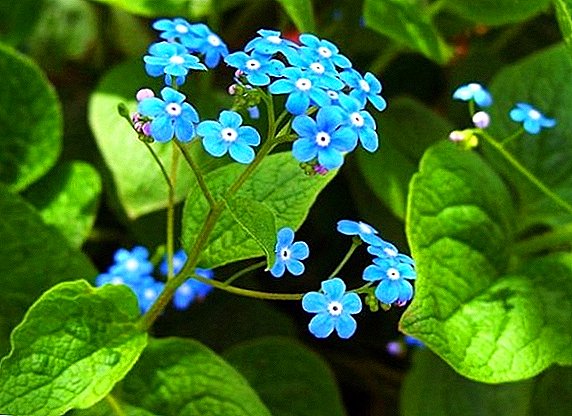 Gardeners appreciate the plant for the fact that its colorful ornamental leaves appear earlier in the garden, and small blue flowers are among the first to please the eye in flowerbeds. They exude a pleasant aroma, which you have time to miss for a long winter. In addition, Brunner is unpretentious in the care, and the varieties can be selected in accordance with the features of landscape solutions.
Gardeners appreciate the plant for the fact that its colorful ornamental leaves appear earlier in the garden, and small blue flowers are among the first to please the eye in flowerbeds. They exude a pleasant aroma, which you have time to miss for a long winter. In addition, Brunner is unpretentious in the care, and the varieties can be selected in accordance with the features of landscape solutions.
Types of Brunners
This perennial plant has only three species, of which two are cultivated. The most popular can be called a large-leaved variety, the natural habitat of which is the Caucasian mountains. Therefore, this type of flower is often called Caucasian forget-me-not. Slightly inferior to her in popularity is the Siberian Brunner, which, as it is not difficult to guess, grows in the forests of Siberia. There is also an Eastern Brunner, whose homeland is the Eastern countries: Lebanon, Palestine, Iraq, Turkey, Iran. But she is not cultivated in ornamental gardening. Therefore, further we will discuss only the first two types of plants.
Did you know? The flower got its official name due to the Swiss botanist and traveler Samuel Brunner, after whom she was named. In the people, it is often called the forget-me-not gorgeous, fake forget-me-not, the forget-me-not, although Brunner and forget-me-not itself belong to different species.
Brunnera macrophylla
This type of flower grows a small bush. The stems produce rough-pubescent, branched, which reach a length of up to 40 cm. The oblong basal leaves have a sharp apex and a heart-shaped shape. Located on long petioles, pubescent below, rough and gray, and dark green above. The flowers are dark blue with a white spot on the core, up to 7 mm in diameter. Collected in paniculate corymbose apical inflorescences. Bloom in mid-April, bloom lasts about a month. With a warm autumn bush may bloom for the second time in a year.  Among the most popular varieties include:
Among the most popular varieties include:
- Brunner large-leaved Jack Frost, which has silver, almost white leaves with green veins, as well as a green border on the edge of the sheet;
- Millennium Zilber is distinguished by leaves with large silver-white spots;
- Langtriz blooms with blue flowers, has dark green leaves, which are covered with silvery specks on the periphery;
- Hadspen Krim produces heart-shaped wide leaves up to 15 cm in length, the edges of which are decorated with a white-cream border;
- Brunner Variegata also has a wide white-cream strip on the edges of the leaves, but it comes on the green parts of the leaf in deep tongues. If the variety is planted in the sun, the leaves will become almost white.
Brunner siberian (Brunnera sibirica)
 This species is larger and more spectacular than the previous one. It has a long and thick rhizome, produces pubescent solitary stems, which reach a height of 60 cm. It grows not a bush, but dense thickets. And her leaves are not the same. Those that grow on the stems, almost lanceolate, sessile. Basal same dense, wrinkled, sitting on long petioles and have a heart-shaped form. Brunner of this species, when flowering, produces dark blue flowers with a diameter of up to 5 mm with a white eye. They are collected in paniculate inflorescences and hold for three weeks. Flowering plant starts in May.
This species is larger and more spectacular than the previous one. It has a long and thick rhizome, produces pubescent solitary stems, which reach a height of 60 cm. It grows not a bush, but dense thickets. And her leaves are not the same. Those that grow on the stems, almost lanceolate, sessile. Basal same dense, wrinkled, sitting on long petioles and have a heart-shaped form. Brunner of this species, when flowering, produces dark blue flowers with a diameter of up to 5 mm with a white eye. They are collected in paniculate inflorescences and hold for three weeks. Flowering plant starts in May.
Site selection and soil for Brunners
As already mentioned, the flower is relatively unpretentious, including the place of planting is not particularly demanding. But under different conditions, its decorative effect can be brighter or smoothed out. So, the most spectacular plant looks in partially shaded areas, when it receives enough sunlight before dinner, and after dinner it is in the shade. With this planting Brunner does not even require special watering.
Brunner grows much worse in a dark garden or in the sun. In the latter case, it abruptly loses its decorative effect, besides it requires constant watering. An exception may be the solar areas near water. With strong heat and insufficient moisture, the flower can dry out, but quickly revives when watering is resumed.
 The large-leaved species of the plant prefers moderately fertile and moist, drained and loose soils. Fertilizing does not require, as they provoke an intensive growth of leaves, because of which the flower loses its attractiveness.
The large-leaved species of the plant prefers moderately fertile and moist, drained and loose soils. Fertilizing does not require, as they provoke an intensive growth of leaves, because of which the flower loses its attractiveness.
The Siberian species grows well in clay and wet soils. Therefore, it is recommended to plant in the northern areas and monitor soil moisture. Unlike the previous species, weed practically does not require, as it has a powerful rhizome.
When deciding where to plant the brunner, give preference to the northern side of the house, the shore of the reservoir, the place under the fruit trees.
Important! The plant does not like fertilizers, especially fresh organic. At the same time in one place can grow up to 15 years.
Planting and breeding Brunners
The reproduction and disembarkation of a plant depends on its species. In any case, after planting the site must be mulched with bark, limestone, sawdust, ash or coffee grounds.
Growing seed brunners
 The flower can be grown from seeds. Large-leaved varieties are sometimes sown on their own, if weather conditions contribute to this. You can collect them in early June, but before planting they require a long stratification - at least two months. Therefore, they are recommended to land in the fall for the winter. The seeded plant gives the first flowering in the third year after planting.
The flower can be grown from seeds. Large-leaved varieties are sometimes sown on their own, if weather conditions contribute to this. You can collect them in early June, but before planting they require a long stratification - at least two months. Therefore, they are recommended to land in the fall for the winter. The seeded plant gives the first flowering in the third year after planting.
Important! Varieties with decorative variegated leaves do not propagate seeds.
The division of the bush brunners krupnolistnoy
The most reliable breeding Brunners - dividing the bush. By the end of the summer, the bush is carefully dug together with a lump of soil, then the shoots are cut so that the hemp remains. Ground from the roots must be removed, but very carefully. To do this, the bush is lowered into the water, and then immediately planted, until the roots are dry. Make sure that each new bush has a root up to 5 cm long and a bud from which the stem will grow next year.
Delenki planted in the ground, not deeply buried, sprinkled on top of the earth and watered. Keep in mind that the flower likes space, but grows quite quickly. Such planting is recommended to be done in October-November, since in spring the plants take root worse and require additional care: shading of young stock in strong heat and constant watering. At the same time, care should be taken to ensure that the soil is not excessively wet. The spring disembarkation takes place in April;
The division of rhizomes of brunners
 Brunner of this type requires special rules for planting and care in the open field. So, it can not be planted in the spring. The best way of reproduction will be rhizome division. To do this, dig up the root in the middle of summer and divide it into pieces of 5-6 cm so that each has a kidney. The resulting seedlings are planted to a depth of 3 cm and well watered. Reproduced in this way the plant blooms next year.
Brunner of this type requires special rules for planting and care in the open field. So, it can not be planted in the spring. The best way of reproduction will be rhizome division. To do this, dig up the root in the middle of summer and divide it into pieces of 5-6 cm so that each has a kidney. The resulting seedlings are planted to a depth of 3 cm and well watered. Reproduced in this way the plant blooms next year.
Selection of neighbors for brunners and use in garden design
Brunner found its use in landscape design. It is used in rockeries, borders, mixborders. Ideal flower looks in the shady parts of water, stones.
Did you know? Any kind of flower looks spectacular when the bush grows more than 30 cm in diameter. Therefore, you need to think carefully about the landing site, so as not to replant the plant.Ideal neighbors Brunners are plants with leaves of decorative shapes and colors. It can be medunitsa, hellebore, geykhera, astilba, rogers, ferns, junipers, buttercups, hydrangeas, hosts, tulips, daffodils and others.
How to care for a brunner in the garden
With the right choice of landing site for the Brunner does not require special care. It quickly grows and suppresses all sorts of weeds. However, you may suffer and the necessary plants. Therefore, it is planted so that there is enough space for growth.
The flowering of brunners lasts just over 20 days. After that, dry inflorescences and faded leaves must be removed. By the end of summer, the plant will acquire fresh leaves. Large-leaved varieties keep their ornamental leaves until late autumn, but they grow more slowly. Therefore, these varieties require a little more thorough care: periodic weeding and watering. 
Important! In the autumn the plant can give repeated flowering. Autumn inflorescences are recommended to be removed so that the flower does not weaken before winter.The root system of the plant is located close to the surface, so it is better to refuse loosening. If the flower is planted on a hill, it is better to mulch.
Pests and diseases of Brunners, how to deal with them
The flower is not prone to disease. Sometimes it may appear brown spot. It occurs from too frequent watering or during the rainy summer. Siberian species may be affected by powdery mildew. To combat these diseases using fungicides, for example, Bordeaux mixture. Before treating a plant, all affected parts must be removed from it.
Brunner pests are whitefly and aphid, but they rarely attack the plant. If, nevertheless, they have chosen a flower, they are fighting with solutions of Karbofos or Aktellika.
How to prepare bushes brunners for winter
 The plant is considered winter-hardy, so special precautions in the preparation is not required. In some varieties, the leaves do not die off by winter, and they must be removed forcibly. The plant tolerates winter well, so it does not require shelter. But if a particularly severe or snowless winter is expected, the soil should be mulched with humus, peat or compost.
The plant is considered winter-hardy, so special precautions in the preparation is not required. In some varieties, the leaves do not die off by winter, and they must be removed forcibly. The plant tolerates winter well, so it does not require shelter. But if a particularly severe or snowless winter is expected, the soil should be mulched with humus, peat or compost.
In the spring with the onset of heat, the shelter must be removed and the soil gently loosened.
Did you know? Brunner leaves the leaves early, so in the northern regions they can freeze during the spring frosts. To worry about this is not worth it, as they quickly restore their decorative effect.
Distillation Brunners
In the fall, the flower bush can be dug, cut off the leaves and planted in a spacious pot with the soil corresponding to the plant variety. The soil is well watered, and the pot is cleaned in a cool place. It may be a dark place in the open air. There he can stand until frost. With their onset, the pot is transferred to a bright room with a temperature not lower than +5 ° C (on the balcony or loggia) and watered as the soil dries. As soon as shoots appear, the temperature is raised to +10 ° C. Then by about December the plant will delight you with new flowers. In the spring, Brunner can be planted again in open ground.
Brunner is a plant that pleases not only with a scattering of blue small flowers, but also with decorative leaves of interesting shapes and colors. Grow it easy. Enough to put in a slightly shaded place near the pond. She drowns weeds independently, does not like fertilizers of the soil, as well as frequent watering. It looks great in flower arrangements in the garden.




